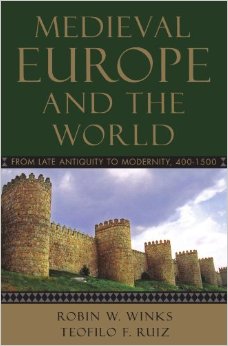Medieval Europe and the World: From Late Antiquity to Modernity, 400-1500 examines the development of western European social, political, economic, and cultural institutions during one of the most complex and creative periods the world has ever known. The book looks at the history of Medieval Europe in relation to its links with the rest of the world, exploring the interaction of western Europe with Islam, the Far East, Africa, and such outlying areas as Scandinavia, Iberia, and Eastern Europe. It considers the genesis and shaping of distinct western ideals, social affairs, economic patterns, and new cultural forms in relation to Islam and Byzantium–two other great civilizations that deeply influenced the growth of western Europe’s unique history. Placing emphasis on medieval Europe’s social and economic transformations and the diversity of social orders, the book analyzes the ways in which these elements interconnected during the formation of medieval society. It also gives special consideration to the twelfth and thirteenth centuries, an era that serves as a bridge between the cultural developments of the early and central Middle Ages and the emergence of new patterns of thought and social organization in the late medieval period.
Featuring nine maps, numerous illustrations, a chronological table, and a detailed list of suggested further readings, this brief but comprehensive narrative is an ideal text for undergraduate courses in medieval history.Medieval Europe and the World: From Late Antiquity to Modernity, 400-1500 examines the development of western European social, political, economic, and cultural institutions during one of the most complex and creative periods the world has ever known. The book looks at the history of Medieval Europe in relation to its links with the rest of the world, exploring the interaction of western Europe with Islam, the Far East, Africa, and such outlying areas as Scandinavia, Iberia, and Eastern Europe. It considers the genesis and shaping of distinct western ideals, social affairs, economic patterns, and new cultural forms in relation to Islam and Byzantium–two other great civilizations that deeply influenced the growth of western Europe’s unique history. Placing emphasis on medieval Europe’s social and economic transformations and the diversity of social orders, the book analyzes the ways in which these elements interconnected during the formation of medieval society. It also gives special consideration to the twelfth and thirteenth centuries, an era that serves as a bridge between the cultural developments of the early and central Middle Ages and the emergence of new patterns of thought and social organization in the late medieval period.
Featuring nine maps, numerous illustrations, a chronological table, and a detailed list of suggested further readings, this brief but comprehensive narrative is an ideal text for undergraduate courses in medieval history.Medieval Europe and the World: From Late Antiquity to Modernity, 400-1500 examines the development of western European social, political, economic, and cultural institutions during one of the most complex and creative periods the world has ever known. The book looks at the history of Medieval Europe in relation to its links with the rest of the world, exploring the interaction of western Europe with Islam, the Far East, Africa, and such outlying areas as Scandinavia, Iberia, and Eastern Europe. It considers the genesis and shaping of distinct western ideals, social affairs, economic patterns, and new cultural forms in relation to Islam and Byzantium–two other great civilizations that deeply influenced the growth of western Europe’s unique history. Placing emphasis on medieval Europe’s social and economic transformations and the diversity of social orders, the book analyzes the ways in which these elements interconnected during the formation of medieval society. It also gives special consideration to the twelfth and thirteenth centuries, an era that serves as a bridge between the cultural developments of the early and central Middle Ages and the emergence of new patterns of thought and social organization in the late medieval period.
Featuring nine maps, numerous illustrations, a chronological table, and a detailed list of suggested further readings, this brief but comprehensive narrative is an ideal text for undergraduate courses in medieval history.
MENUMENU

